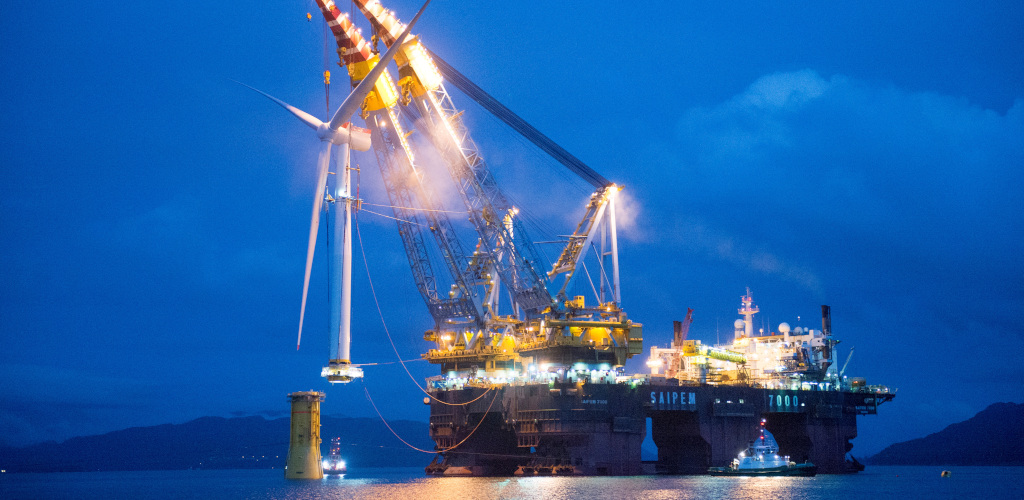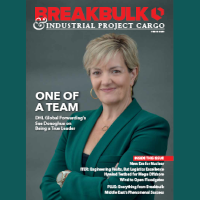Testbed for Mega Offshore Wind to Open Floodgates

By Iain Macintyre

Technology-advancing offshore wind projects such as the recently commissioned Hywind Tampen development in the North Sea signal a rich, ongoing vein of project and breakbulk opportunities in Europe.
As the world’s largest floating offshore wind power plant – and the first to power offshore oil and gas platforms – Hywind Tampen is serving as a testbed for the development of new and larger turbines, logistics and installation methods.
Located about 140 kilometers from the Norwegian coast in an area with water depths of 260-300 meters between the Snorre and Gullfaks oil and gas platforms, Hywind Tampen required ballast-stabilized floating foundations, anchored to the seabed with mooring lines.
 Siemens Gamesa's head of wind offshore portfolio management Stephan Buller embraced the “strong collaboration” with energy company Equinor, which has seen his firm provide 11 SG 8.0-167 DD turbines to the “giant leap forward in floating wind.”
Siemens Gamesa's head of wind offshore portfolio management Stephan Buller embraced the “strong collaboration” with energy company Equinor, which has seen his firm provide 11 SG 8.0-167 DD turbines to the “giant leap forward in floating wind.”
“Hywind Tampen provided a lot of lessons in regard to logistics and harbor-based installation methods,” he said to Breakbulk. “Potential upcoming projects with larger turbines will benefit from these lessons for sure.”
Given its lightweight nacelles, Siemens Gamesa’s large, direct-drive wind turbines were considered particularly suited for Hywind Tampen’s floating foundations. Albeit Buller notes the particular turbines used were in fact quite similar to those also deployed in bottom-fixed projects.
Commencing power production from its first turbine on Nov. 13, 2022, Hywind Tampen is expected to have a total capacity of 88MW when its remaining four turbines come on stream this year. It is to meet about 35 percent of the annual power demand of the Snorre and Gullfaks platforms and, by reducing the use of gas turbines on the fields, contribute to reducing CO2 emissions by over 200,000 tonnes per year.
MEETING OFFSHORE NEED
A key contributor to the project has been heavy-lift transport company Mammoet, which was engaged to undertake turbine assembly and associated port handling work, explained the firm’s project manager Martin Tieman.
“We recognized that we would need a crane with a huge outreach to make the required lifts,” he said. “The majority of land-based cranes in any fleet would not be able to achieve a 143-meter distance at these weights, but we knew that if it could be done the project would benefit significantly. This would create a smooth production line from marshalling yard to turbine assembly to commissioning – all at the same location – optimizing the use of offshore assets.
“This led us to look at the use of our PTC 200-DS crane, which is proving to be in high demand for big offshore wind projects such as the Greater Changhua development in Taiwan and Seagreen Offshore Wind Farm in Scotland.”
Once the port had confirmed the quayside would be able to provide the required ground-bearing pressures, Mammoet was able to put together a plan for port handling and assembly of all 11 turbines of Equinor’s development.
Siemens Gamesa considers the offshore wind sector to already have a strong foothold in Europe, with close to 18.5GW of installed capacity and global potential to reach over 100GW by 2030. Of this, floating offshore wind is estimated to constitute 10 percent of the market, potentially powering 12 million homes in 2030.
“For floating wind, Europe is a very important market,” Siemens Gamesa’s Buller said. “Markets like the UK or Norway are frontrunners but also France, Spain and Portugal have very concrete ambitions to develop largescale floating wind projects. Beyond Europe, we see strong activities in Asian markets (for example, Korea and Japan), but also in the U.S. (West Coast) and some other places.”
Moreover, Buller describes Hywind Tampen as a “small-capacity project” compared with those potentially on the horizon.
“Floating wind farms open up many new regions that would be unsuitable for bottom-fixed foundations. An increase in the size and number of wind farms per year will directly drive demand for shipping.”
However, the increasing size and weight of wind turbine components will require vessels with larger capacity than what is currently available. “The shipping market appears to be stretched already with the number of projects in parallel – bigger and better vessels are always going to be welcome in the industry,” Buller said.
CALL FOR FOUNDATION MOVERS
 Mammoet global segment lead for offshore wind Francisco Rodrigues sees the sector continuing to provide significant new project and breakbulk shipping opportunities, in particular through the supersized foundations needed for fixed-bottom offshore wind, which will over the coming years. These need to be transported vast distances from fabricator to installation site, he said. “As these components continue to grow, finding innovative ways to load and unload larger quantities per vessel will play a large part in increasing the efficiency of offshore wind projects, and ultimately the cost of energy to consumers.”
Mammoet global segment lead for offshore wind Francisco Rodrigues sees the sector continuing to provide significant new project and breakbulk shipping opportunities, in particular through the supersized foundations needed for fixed-bottom offshore wind, which will over the coming years. These need to be transported vast distances from fabricator to installation site, he said. “As these components continue to grow, finding innovative ways to load and unload larger quantities per vessel will play a large part in increasing the efficiency of offshore wind projects, and ultimately the cost of energy to consumers.”
While Rodrigues observed that the majority of suppliers to the offshore wind market are indeed located in Europe, he also sees the market expanding rapidly worldwide, not least in the U.S., where 10GW-15GW of additional offshore wind power is expected by 2030. Before the end of the year, there will be three overlapping projects on the East Coast with over 60 units each – Vineyard Wind (800MW), Revolution (704MW) and Coastal Virginia (2600MW).
“As the leading supplier of engineered heavy lifting and transport services, we are well-placed to transfer our decades of expertise on European fixed bottom and floating wind projects to new markets,” he said.
Rodrigues added that as turbines grow taller to reach stronger, more reliable wind flows, all associated components will continue to grow – from floating foundations to monopiles, to tower sections and nacelles.
“This will require larger vessels and smart loading strategies – especially given the Jones Act restrictions on nonU.S.-flagged vessels that are in place in the U.S. All members of the value chain will need to work together to solve these challenges.”
Iain MacIntyre is a New Zealand-based, award-winning journalist, with lengthy experience writing in the global shipping scene.
MAIN IMAGE: the 30-GW Hywind Scotland offshore wind project. CREDIT: Hywind
